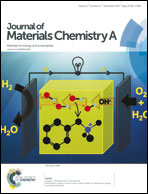Enhanced lithium storage capacity of Co3O4 hexagonal nanorings derived from Co-based metal organic frameworks†
Abstract
Co3O4 with high capacities and energy density has potential applications to be electrode materials for lithium ion batteries, one of the most important power sources. For improving the cycling stability, the Co3O4 nanostructures are required. Herein, we report successful construction of Co3O4 hexagonal nanorings and nanoplates/nanoparticles via treating Co-based metal organic frameworks (MOFs) with organic amine. The studies show that the release rate of Co(II) to the reaction system and the spatial hindrance of the organic linkers of MOFs determine the final morphology of Co3O4. As an anode for lithium ion batteries, Co3O4 hexagonal nanorings with 1370 mA h g−1 specific capacity after 30 cycles displayed higher reversible capacity and better stability than commercial Co3O4 particles with only 117 mA h g−1 specific capacity after 30 cycles. The improved performance of Co3O4 hexagonal nanorings could be attributed to the shortened transfer path for Li+ afforded by the special morphology. It is expected that plentiful metal oxide nanostructures could be constructed from MOFs due to the available versatile categories of MOFs.


 Please wait while we load your content...
Please wait while we load your content...